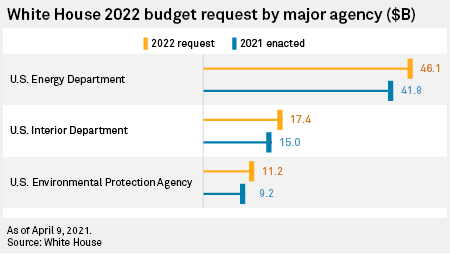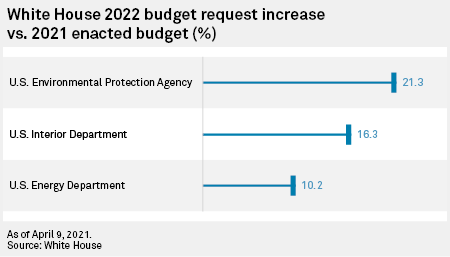S&P Global Offerings
Featured Topics
Featured Products
Events
S&P Global Offerings
Featured Topics
Featured Products
Events
S&P Global Offerings
Featured Topics
Featured Products
Events
Banking & Capital Markets
Economy & Finance
Energy Transition & Sustainability
Technology & Innovation
Podcasts & Newsletters
Banking & Capital Markets
Economy & Finance
Energy Transition & Sustainability
Technology & Innovation
Podcasts & Newsletters
S&P Global Offerings
Featured Topics
Featured Products
Events
9 Apr, 2021
By Molly Christian and Zack Hale
U.S. President Joe Biden called for a more than $14 billion increase in climate change investments in fiscal year 2022, including a 10% increase in the Department of Energy's budget, as he seeks to decarbonize the U.S. power sector and broader economy.
The White House Office of Management and Budget released its fiscal year 2022 discretionary budget request to Congress on April 9. The proposal seeks to raise non-defense discretionary funding to $769 billion, up 16% from 2021 enacted levels. National defense programs would receive $753 billion, a 1.7% increase.
The request includes major investments to address climate change and boost federal research and development of clean energy technologies, priorities Biden has woven into his recent infrastructure proposal and efforts to reinvigorate the U.S. economy amid the coronavirus pandemic.
"This year's appropriations process arrives during one of the most difficult periods in the nation's history," OMB Acting Director Shalanda Young said in the request. She noted that the country is facing "four compounding crises": a once-in-a-century pandemic and related economic crisis, a national reckoning on racial inequity, and "the growing threat of climate change."
But those challenges present an opportunity to "begin building a better, stronger, more secure, more inclusive America," Young asserted.
The request now stands before Congress, which will hold hearings in the coming weeks on budgets for individual agencies and spending areas before drafting appropriations bills. Although Democrats control both chambers of Congress, they hold thin majorities and will need to work with various factions within their own party and Republicans on final legislation that will likely differ from Biden's plan.
Tackling the climate crisis
That proposal includes $1.7 billion for energy-saving retrofits to homes, schools, and federal buildings, and $600 million for electric vehicles and charging infrastructure throughout the individual budgets of 18 federal agencies. Other climate items include $815 million to incorporate climate impacts into pre-disaster planning and "projects to ensure that the nation is rebuilding smarter and safer for the future," a $540 million increase above the 2021 enacted level. And over $550 million would be provided to remediate thousands of oil and gas wells and reclaim abandoned mines.

Non-defense spending on clean energy innovation would surge to $10 billion, a more than 35% increase over 2021, with the investments to cut emissions from the electric grid, transportation, buildings and industrial sectors. The request would also provide $1 billion to create a new Advanced Research Projects Agency for climate change modeled after the existing Advanced Research Projects Agency-Energy.
Turning to specific agencies, the DOE's budget would jump to $46.1 billion, a $4.3 billion or 10.2% increase year on year. Among other things, the funding would support streamlined transmission permitting and "programmatic infrastructure for a new energy efficiency and clean electricity standard," a major plank of the Biden administration's climate agenda.
The request would invest more than $8 billion, a 27% or more annual increase, in technology such as advanced nuclear energy, electric vehicles, and green hydrogen produced from zero-carbon resources. At the same time, the DOE would increase funding for the Office of Fossil Energy and Carbon Management, which works to reduce emissions from hard-to-decarbonize sectors through technologies such as carbon capture and sequestration and direct air capture.
Following repeated attempts by former President Donald Trump to slash the U.S. Environmental Protection Agency's budget, the Biden administration is seeking the opposite: a 2022 discretionary request of $11.2 billion, a $2 billion increase from fiscal year 2021 appropriated levels.
Out of the three primary federal agencies with jurisdiction over the U.S. energy sector — the EPA, DOE, and Interior — the EPA would see the largest relative budget request.

In justifying the increase, the White House pointed out that the EPA's funding levels have been cut 27% since fiscal year 2010, adjusted for inflation. Noting that the agency lost nearly 1,000 staff during the Trump administration, the White House is aiming to invest $110 million to "restore EPA's critical staff capacity and to rebuild programmatic capabilities."
The budget request includes a $48 million increase for the EPA's Office of Air and Radiation, a powerful office tasked with writing regulations that cover the largest sources of U.S. greenhouse gas emissions such as power plants and the nation's transportation sector. The Biden administration is also seeking an additional $100 million in air quality grants for state and tribal Clean Air Act programs designed to reduce greenhouse gas emissions.
The EPA's budget request would also make "the largest investment in environmental justice" in U.S. history, with $936 million dedicated to a new "Accelerating Environmental and Economic Justice initiative." The White House said the initiative is part of its commitment to channel 40% of the benefits of U.S. climate investments to disadvantaged communities.
"The FY 2022 discretionary request for EPA makes historic investments to tackle the climate crisis and to make sure that all communities, regardless of their zip code, have clean air, clean water, and safe places to live and work," EPA Administrator Michael Regan said in a statement. "Today's announcement recognizes that science is at the core of all that we do at the EPA and says loud and clear that the EPA is back and ready to work."
Turning to the Interior Department, the discretionary request includes $17.4 billion for the agency, a 16% increase from the 2021 enacted level. Along with money to clean up abandoned wells and mines, the proposal would provide $4 billion for Interior to fund a range of tribal programs, including for clean energy development, up by more than $600 million year-over-year.
The budget also sought an additional $550 million from the prior year to "decrease climate pollution, accelerate clean energy deployment, and expand efforts around climate adaptation and ecosystem resilience among all [Interior] land management agencies."
Environmental groups and Democratic leaders in Congress praised the April 9 request. Senate Appropriations Committee Chairman Patrick Leahy, D-Vt., said the proposed budget request was "necessary and urgent" and "reflect[s] the real needs of the American people."
But key Republicans blasted the proposal, foreshadowing partisan fights during the appropriations process.
"The president's proposal shows an administration that is less interested in the primary responsibility of the federal government, to ensure the safety and security of the American people, while it looks to further fuel growth of government in those areas that enhance Washington's control and interference in the lives and livelihoods of the American people," said U.S. Rep. Jason Smith, R-Mo., ranking member of the House Budget Committee.
